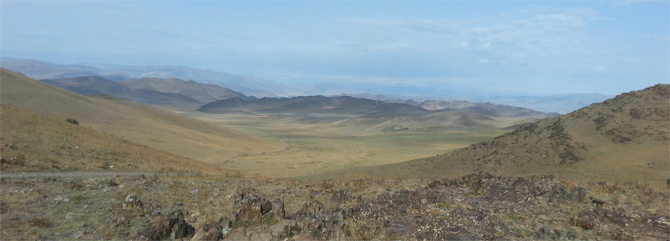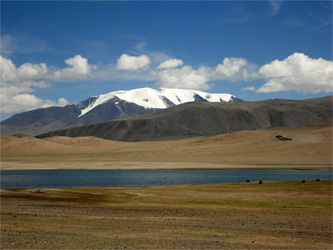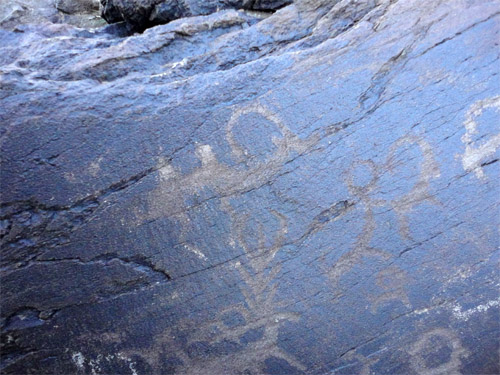It was wonderful experience. we had some bad weather, but it gave me the opportunity to spend more time with nomad family and it was a very enriching time. Our guide Tuvshee was joyful and friendly and most importantly a very good cook (in extreme conditions) during tent camping. We want to come back and we will buy a ger to put in our garden!
~ Anais Julienne & Bernardo Montufar, FranceRegister and receive interesting information and travel news
In countryside, it is very hard to find out your favorite dried fruit, choco bars, peppermint or so on.. For long way to drive on, it is suggested to pack this kind of things in your hand bag....
View More »
KHOVD PROVINCE
HOW TO GET: by jeep 1700 km & 45 hours drive, 3 nights & 4 days drive
Khovd is distinguished by its multi-cultural population and its rock mountains in Altai Mt range. More than 17 ethnicities: Khalkh majority and Khoton, Kazakh, Uriankhai, Zakhchin, Myangad, Oold and Torguud peoplesare neighbouring to each other. Each of these groups has its own distinct traditional dwelling and pattern of decoration, dress and other cultural distinctions, literary, artistic, and musical traditions.

Sangiin Kherem Wall ruins
The history of Hovd town dates back about 240 years. At the north end of town there is a ruined fortress where the Manchu dynasty Viceroy (Qing Dynasty) lived with his troops. It was built around 1762 by Manchu warlords. While the Manchus (Half tibet and half north chinese tribe) were ruling, they planted trees along the main streets that can still be seen today for 200 years. The 40,000 sq.m walled-compound was containing several temples, a Chinese graveyard and the homes of the Manchu rulers. The mud and brick walls are 2m deep, 3m wide and around the 4m-high. This flourishing Manchu city was destroed by chinese 1500 men after 10-day siege and two-day battle in August 1912.
Khar Us Nuur Lake Natural Park
The Khar Us Lake national park is designated as park in 1997 to protect the 15800 hectares area including Khar Us lake and Dorgon lake's ecosystem. Khar Us Nuur (Black Water Lake) is the second largest freshwater lake with size of 72 km long and 26 km wide, but with an average depth of only 4m. It has more than 10 islands in the middle and some trees and tall grasses near the shores. The biggest island is called as Agshab and it is 30 km wide and is elevated in 272 m above the lake level. It looks like dividing the lake into 2 pieces: north and south.
Khovd river flows into this lake, creating a giant marsh delta. Khar Us Nuur is the perfect habitat for wild ducks, geese, wood grouse, partridges and seagulls, including the rare relict gull and herring gull. The lake is good place for birdwatching in May and late August. The lake is huge, difficult to reach because of the marshes, and locals know very little, is disappointing. The delta where Khovd river enters the lake and south banks , and north west shores are good place to see the lake and birds. In July and August another photographing object at this park is lotus flowers in 3 colours: pink, whitish and rose colored lotuses.

Khoid Tsenkheriin Agui Cave
One of Hovd aimag's best known attractions are the cave paintings at Tsenkheriin Agui. These red-ochre paintings are believed to be 15,000 years old, which would date them in the Late Stone Age (or Upper Paleolithic Age). The drawings depict a wide variety of animals, some are readily identifiable, such as camels, sheep, bulls, and ibex, others are open to the interpretation of the viewer, such as a drawing of what appears to be an ostrich. Not only this one, but it continues with pictures of elephant, mammaths, tigers, which don't exist in present Mongolian territory. These rock paintings and some mongolian nouns for this tropical animals prove us that the western mongolian territory was habitated by both of animals 15000 years ago.


Tsambagarav Mountain National Park
Tsambagarav Mountain National Park is spread over an area of 110 hectares around Tsambagarav mountains, Namarjin plateau and several galciers. It is one of the most glorious snowcapped peaks in Mongolia and despite its altitude of 4202m the summit is relatively accessible and easy to climb with ropes and crampons. Namarjin Valley,where there are excellent views of Tsamba-garav.
It houses a number of endangered animals such as snowleapords, wild cats, lynx, ibex and mountain goat and the wildlife watching and hiking or horse riding activities are available to discover the park more details. There uuld, torguud, kazah and khlakh ethnic people lived in the surrounding areas of the park and they are very kind to show you their cultural performance and they can lead you to the Turkic stone-men and petro glyph in the mountain.
Zereg Mankhan National Park
Zereg Mankhan National park is designated in 1998 as covering 40000 hectares of steppe and rock hills to protect the endamngered species of animals such as saiga tatarica mongolica, wild ass and wild sheep and ibex and so on.. Numbers and distribution of ths saiga antelope decline since many years, because of competition with domestic livestock, severe environmental and weather phenomena and poaching. Population numbers are fluctuating for the last few years from about 5.200 in 2.000 to 800-1.000 in 2001.
Call our travel expert at:
Tel worldwide: 976-9985 0823, 976-88807160
Tel domestic: 976-70110823
Fax: 976- 7011 0823
Skype: Blue Mongolia Travel agency
Ulaanbaatar Time Now (GMT+7):
Our Office hours is 9:00 to 17:00 Monday to Friday.
Write and send your request at:
info@bluemongolia.com, service@bluemongolia.com
Post address:
Reciepent 99850823, Building 80, Ikh Toiruu Street, Sukhbaatar District, Ulaanbaatar 14192, Mongolia